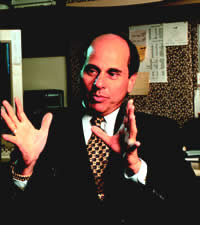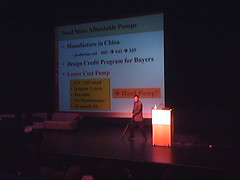It was recently the birthday of former American president [[Woodrow Wilson]], someone who knew about trying to be innovative and bringing about change. He pushed major legislation through Congress, entered World War I, and sought to establish the League of Nations. He said, “If you want to make enemies, try to change something.“
Category: People
-
Americans Online
The NY Times covers the new census figures…
Among adults, 97 million Internet users sought news online last year, 92 million bought a product, 91 million made a travel reservation, 16 million used a social or professional networking site and 13 million created a blog.
-
Goodbye Leslie
I just learned Leslie Harpold past away. She and I didn’t know each other well; we shared some mailing lists and traded some emails. But we didn’t know each other well for a while — I can vividly remember reading her circa 1999. In my mind she is one of that small group of passionate people who loved the web from the earliest days and devoted a great deal of effort to exploring what it could be, so in some small way I feel we all owe a tiny debt of gratitude to Leslie for making the web a wonderful place.
-
Prediction markets blog
My friend and former co-worker Alex Kirtland is reviewing public prediction markets on his blog. Given how important a clear understanding of the market is to the accuracy of participants’ voting, I appreciate the POV of someone like Alex who groks good digital design.
-
Interaction Design as Language Design?
 Marc Rettig, one of the most thoughtful practioners in the user experience world, will be in New York next month discussing Interaction Design is Language Design…
Marc Rettig, one of the most thoughtful practioners in the user experience world, will be in New York next month discussing Interaction Design is Language Design……The notion of a “design language” has been with us for years, but if we take the idea seriously, perhaps ideas and frameworks from linguistics can help us design better interfaces. The goal of the topic is to create a grounded practice using the explored principles. The seminar is not meant to be a completed theory, but a work in progress that participants get to explore with Marc during the seminar and after on their own work.
-
More business design quotes
I added thoughts from Peter Senge, Ray Stata and Ed Simon to the Design Thinking and Business quotes page. Ed Simon’s is the earliest reference I’ve found of the term business design used in this context.
-
Motorola’s Zander leading the charge
 Christopher Rhoads lobs some harmless questions at Motorola’s CEO Ed Zander ($) in today’s WSJ. Luckily Zander steps up and honestly assesses the company’s challenges, shortcomings and approach. Excerpts:
Christopher Rhoads lobs some harmless questions at Motorola’s CEO Ed Zander ($) in today’s WSJ. Luckily Zander steps up and honestly assesses the company’s challenges, shortcomings and approach. Excerpts:On learning the importance of cool…
When I came here on January 1, 2004, I didn’t think much about cool. I thought about making a quarter, meeting financials, meeting customer-delivery dates, developing the products on time, better quality. [He picks up a RAZR cellphone.]…I bumped into this thing a year ago April, and I thought it was cool. I would walk around with it on the streets of Chicago or in restaurants or with friends, and when they saw the RAZR, they just couldn’t believe this phone and said, ‘I gotta have it.’
On what needs to improve…
Motorola’s got a thick culture. I had to learn it, and it’s been hard bringing the things I think are valuable, such as a sense of urgency, fast decision making, shareholder value, competition. I don’t want to imply that none of that was there, but it was not to my liking, not after living in Silicon Valley for 17 years. I got the feeling that there were days the company was on autopilot to a degree.
On how to change the culture…
I think we ought to get back to putting the customer first. As simple as that sounds, I think it’s something that every American corporation, every corporation around the world, sometimes takes for granted.
He seems to incorporate the innovator’s dilemma into his management style…
Whack yourself before somebody whacks you. I used to have these meetings called the whack meetings at Sun where we’d think about what could happen to us and what we have to do to keep that from happening. That approach led to the creation of Java and a lot of the Internet.
On transformation:
The real challenge for corporations that are trying to transform is in the VP ranks. That’s where the blockage is. A lot of companies have clogged arteries. So we have undergone a transformation of our vice president ranks. I don’t know how many dozens of VP’s are no longer with us. Some have left on their own accord, some have not.
-
Martin Fisher is my new hero
Martin is co-founder of Kickstart (formerly Approtec), an organization designing products for the bottom of the pyramid. As opposed to C.K. Prahalad who tends to describe the poor as consumers (see sachet marketing), Martin views the poor as investors. I met him at the ID Design Strategy conference this past week where he told me, “everyone has the same basic need: a way to make money.” So Kickstart researches what the poor in Africa need to make money. Because subsistence farming is common, Kickstart designed a pump that allows farmers to irrigate crops using nearby streams or wells, dramatically increasing crop output and helping the poor enter the middle class. They’ve created other products to help the poor create bricks, hay bales, cooking oil, and so on. By designing inexpensive products and selling them, it ensures the technology finds its way into the hands of people who will use it, a model sustainable beyond charity.
If design is our attempt to ‘change existing situations into preferred ones‘ then Martin was the best designer at the conference.
-
Niti Bhan
I finally met the lovely and vivacious Niti Bhan at the ID Design Strategy conference. She gave me one of her hilarious business cards and I discovered she has a blog, check it out.
-
Dan Pink podcast
Todd of 800-CEO-READ interviewed Dan Pink, author of A Whole New Mind: Moving from the Information Age to the Conceptual Age.
-
Empathy and the design of JetBlue
David Batstone recaps a conversation with David Neeleman, the CEO and founder of JetBlue in the March 2005 Harvard Business Review and shows perfectly how the empathy of great design thinking improves both human experience and the bottom line simultaneously:
For starters, Neeleman was troubled by the vast inequities of privilege and poverty he saw firsthand in Brazil. Note that JetBlue today tries to eliminate stark differences that affect how customers are treated. The airline offers only one class of seats. In fact, the seats that have the most legroom are the situated at the back for those people who have to get off the plane last. In-flight services as well are offered to all customers with equal attention. In return, JetBlue enjoys an unusual depth of customer loyalty.
This begs a direct comparison to Herb Kelleher of Southwest Airlines who included employee job satisfaction as an integral piece in his strategy, a key differentiator in an industry in “a race to the bottom”.
-
Richard Farson
I stumbled across Richard Farson’s site looking for an old HBR article he wrote, and discovered a wealth of excellent thinking, synthesizing ideas on business design, organizational design and designers.
The article from HBR, The Fault-Tolerant Leader (free here), hits on all the important reasons management needs to accept risk in order to innovate. His articles Management by Design and Designers as Leaders are excellent as well.
-
Maeda’s simplicity blog
Mike Lee just told me about John Maeda’s new Simplicity blog (where John is coincidentally blogging about Mike.)
While simplicity is a noble pursuit, we live in a complicated world and I was curious to know how Maeda could suddenly pounce on us with such a manifesto while surrounded by the complexity of work at MIT. The blog refreshingly shows his work-in-progress as he figures it out himself, such as by distinguishing simplicity from simplistic.
Also, Jess has revived interactionary.
-
Remember Quokka?
I just discovered the work of Mark Allen Nakamura who designed some of the old Quokka Sports site, still one of the most daring and bold layouts to appear on a mainstream site.
-
PBS series on innovation
They Made America is a four-part series in November:
American history is filled with the stories of influential innovators, whose ideas and entrepreneurial spirit gave birth to commercial milestones like the steamboat and cultural touchstones like the Barbie doll. Twelve of these individuals are profiled in They Made America, a four-part television series from the producers of American Experience.
